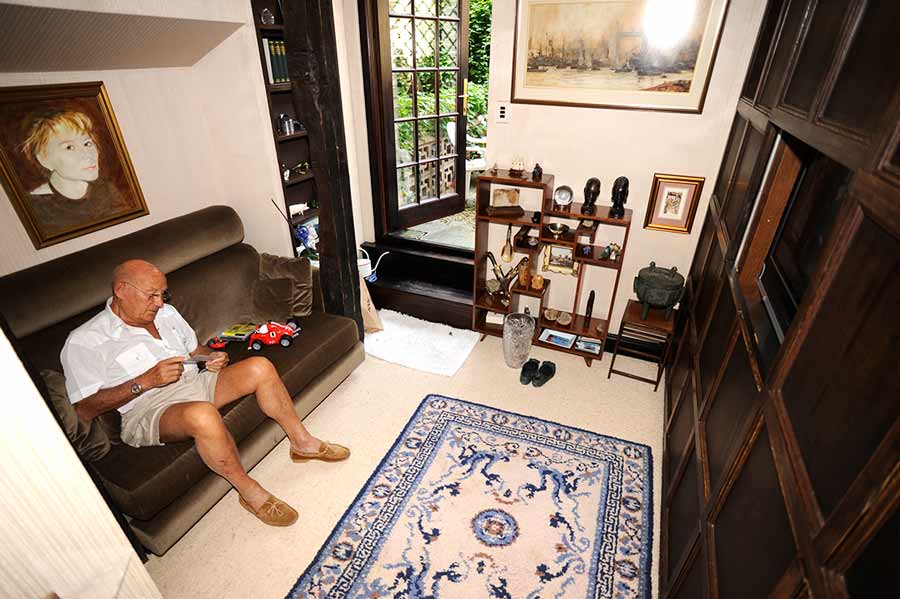
The House That Moss Built, written by Philip Porter in 2009
The Personal Organiser House
A mark of how extraordinary Stirling’s Mayfair mews was in the '60s is that it has stood the test of time. Like all good design and original thought, it is as fresh and contemporary now as it was when built in 1962.
We now have computers, digital sound and images, home cinemas and all sorts but who else, other than Stirling Moss, has a table that descends from the kitchen to the floor below, a tray that carries items from an office on one floor to an office on another and the means to run a temperature-controlled bath from any other room? Heath Robinson would have been proud of Stirling!

So, completely untrained and using a mix of common sense, observation, practical thought and innovation, Stirling set to work in 1960/61 designing a new house from scratch. He had bought the small site in the heart of Mayfair. A German bomb had thoughtfully cleared a small area for him to build what used to be called his 'dream house' – Ideal Home meets Grand Designs!
‘I would start by asking, “What do I need?’ How many bedrooms do I need? How many bathrooms do I need? Where should they be? Do I want to be on my own on one side or whatever?” I would lay it out on a plan and then I would look at the plan and think, well it would be nice if I did this and that, and I put in the windows where I wanted them and that sort of stuff, and it just happens.’
He sacked the first architect, who probably refused to contemplate so much fresh thinking. You can just imagine it. 'Oh, we don't do things like that. No-one has ever done that before so we can't. You want to do what?'
Stirling drove the project, retaining a female architect to translate his ideas into reality. It was a very 'technical' design for it involved going down, as well as up. Today people are building estates under their London mansions but in 1962 it was less usual to have your guest bedroom underground.
The house is narrow, dictated of course by the width of the small site between two existing buildings. There is a hall leading from the central front door, with a garage on either side. One garage extends to the back of the site, with a great deal of storage space beyond the area for a car. Stirling has a series of metal storage racks on rails so they can be slid together normally and only parted for access, rather like a library book storage system.
At the rear of the other garage is his office, the nerve centre. A spiral staircase makes maximum use of space and descends to the guest area and ascends to the first floor on which are a large sitting room, a small 'snug' off this with TV and video, plus Lady Susie's office. Climbing again reaches the large kitchen with another relaxation area (not that either of them do much of that), and the dining room. Above is the master bedroom, walk-in wardrobes with motorised shutters, the main bathroom and yet another floor houses a second guest room and balcony.

Stirling had to go to Germany for the large sitting room windows which open conventionally, or tilt open at the top – more prevalent today but radical in the early sixties. ‘In Germany they have some incredible hinges; they do have some wonderful hardware and ironmongery.’ Stirling is a real hardware enthusiast with an almost religious zeal.

Like the man himself, the house is small, neat, precise and very well organised. It has be because of the lack of space in this prime central London spot.

‘With my house, there is a place for everything and everything is in its place. I try to keep it that way.’

‘If I want to run the bath, I can push a button on any floor and all that does really is it actuates three electronically-controlled hydraulic valves, which are what radiators have. One of them closes, that is the waste, and the other two are on hot and cold and they open. So, now the water is coming out hot and cold. It then goes through one of those bi-metal jobs, so you can’t scald yourself, so I set the temperature. I always have the same; I can change it but not remotely. So then the bath runs for five minutes, 20 seconds, or whatever it is, and there it is, ready to go. That to me is very convenient. I don’t have to swill it round and I don’t have to watch out for it to overflow. That is very convenient.
‘I have a radio controlled garage door, which is now very ordinary but in 1962 it wasn’t. I have got the descending table, which is the device whereby you can send a meal down from one floor – the kitchen - down onto the floor below on a sort of table at which you can sit. That is pretty convenient. My descending table is actually a Ratcliffe tailgate [used on lorries]; that is all that is. It is the way it is put in that matters.

‘What else have I got? Instant boiling water, which is the most beneficial thing and most used, which anybody can get hold of. They are really quite common now but that is my most used item. If I am going to make coffee or tea, I do not need to boil a kettle.’
Convenience and time-saving are a common theme. But comfort has its place as well.

‘I have heated toilet seats, so if you are a long time on the loo, you have got the pleasure of that!’
We now live in an age when energy conservation and a Green agenda increasingly dominate our lives. Can Stirling relate to all this?
‘Efficiency, yes. The Green thing, I don’t fully understand but I like to design things that are functional. If I ever build another house, I have got quite a lot of ideas for it. Now we have got solar panels and so on which are very common which they weren’t a few years ago. Quite a lot of things like that which I think are very good.’
Is Moss tempted to update the London house?

‘That is interesting because I have been wondering if I should do a makeover. Quite honestly, there are things one could always change but it is difficult here in this place because I have got the circular staircase, which is established.
‘When I look around, I have got most of the things I would want. I have got my boiling hot water out of the tap, I have got the running bath. I can’t think of that many other things.’
Has Stirling Moss, the designer, run out of ideas or was he actually so far ahead of his time that few worthwhile developments have appeared in the last (nearly) 50 years that there is little else conceivable for him to tax his ever-inventive, questioning, problem-solving mind?
If you liked this article, and are not already on our database, please click on the button below to be kept up to date with our newsletters, latest news, blogs, special offers and more.
Please note: by subscribing you will be joining our Mailchimp mailing list. We take our subscribers' privacy very seriously. Please click here to view our privacy policy.







Leave a comment
This site is protected by hCaptcha and the hCaptcha Privacy Policy and Terms of Service apply.